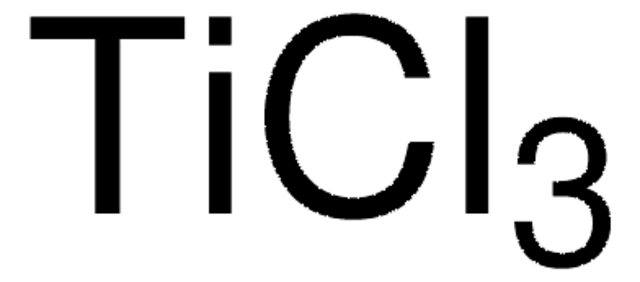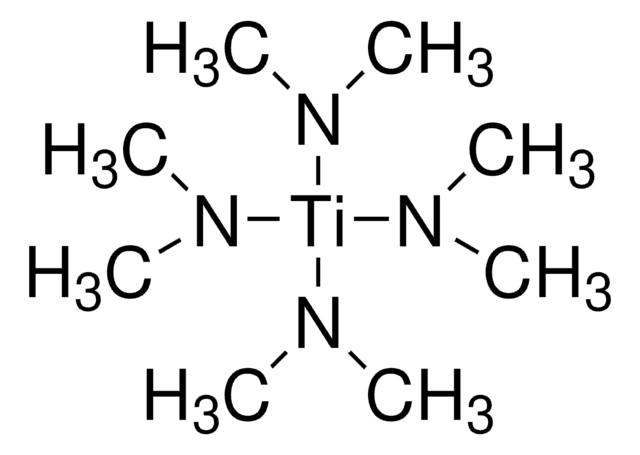Kluczowe dokumenty
697079
Titanium tetrachloride
packaged for use in deposition systems
Synonim(y):
Titanium(IV) chloride, TTC, Titanium tetrachloride
About This Item
Polecane produkty
ciśnienie pary
50 mmHg ( 55 °C)
9.6 mmHg ( 20 °C)
Próba
≥99.995% (trace metals analysis)
Formularz
liquid
przydatność reakcji
core: titanium
reagent type: catalyst
bp
135-136 °C (lit.)
mp
−25 °C (lit.)
gęstość
1.73 g/mL at 20 °C (lit.)
ciąg SMILES
Cl[Ti](Cl)(Cl)Cl
InChI
1S/4ClH.Ti/h4*1H;/q;;;;+4/p-4
Klucz InChI
XJDNKRIXUMDJCW-UHFFFAOYSA-J
Szukasz podobnych produktów? Odwiedź Przewodnik dotyczący porównywania produktów
Opis ogólny
Zastosowanie
- γ,δ-unsaturated alcohols from allylsilanes and carbonyl compounds,
- N-Phosphinoylimines and N-sulphonylimines from aromatic aldehydes,
- Homoallyl ethers from allylsilanes and acetals.6
Hasło ostrzegawcze
Danger
Zwroty wskazujące rodzaj zagrożenia
Zwroty wskazujące środki ostrożności
Klasyfikacja zagrożeń
Acute Tox. 1 Inhalation - Eye Dam. 1 - Skin Corr. 1B - STOT SE 3
Organy docelowe
Respiratory system
Zagrożenia dodatkowe
Kod klasy składowania
6.1A - Combustible acute toxic Cat. 1 and 2 / very toxic hazardous materials
Klasa zagrożenia wodnego (WGK)
WGK 1
Temperatura zapłonu (°F)
Not applicable
Temperatura zapłonu (°C)
Not applicable
Środki ochrony indywidualnej
Faceshields, Gloves, Goggles, type ABEK (EN14387) respirator filter
Wybierz jedną z najnowszych wersji:
Masz już ten produkt?
Dokumenty związane z niedawno zakupionymi produktami zostały zamieszczone w Bibliotece dokumentów.
Produkty
igma-Aldrich.com presents an article regarding the savannah ALD system - an excellent tool for atomic layer deposition.
Since the demonstration of the first practical solar cell 60 years ago, research on novel materials, improved solar cell design and structure, and innovative manufacturing processes have all contributed to a continuous increase in the efficiency of photovoltaic (PV) devices.
Nanomaterials are considered a route to the innovations required for large-scale implementation of renewable energy technologies in society to make our life sustainable.
The properties of many devices are limited by the intrinsic properties of the materials that compose them.
Nasz zespół naukowców ma doświadczenie we wszystkich obszarach badań, w tym w naukach przyrodniczych, materiałoznawstwie, syntezie chemicznej, chromatografii, analityce i wielu innych dziedzinach.
Skontaktuj się z zespołem ds. pomocy technicznej







